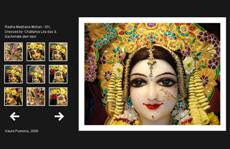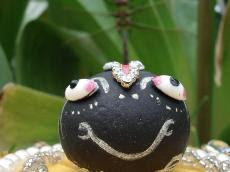About Ratha Yatra:
Ratha Yatra festival comes in the rainy season, during the months of June and July. This is a special event in the eastern part of India, particularly in Puri, in the state of Orissa. It is held in honor of Lord Jagannath, which literally means the Lord of the Universe. Jagannath is a form of Krishna.
The name of Puri comes from the word Janagannathpuri which means the home of the Lord of the Universe, Jagannath. There is a big temple of Jagannath in Puri. It is one of the four major traditional centers of pilgrimage in India. The temple of Lord Jagannath enshrines wooden images of Lord Krishna, his brother Balaram or Balabhadra and sister Subhadra. The massive temple was built nearly eight centuries ago. The images stand in a row. The fair-colored Balaram, stands on extreme left. Dark-colored Krishna or Jagannath is on the extreme right and the yellow-colored sister Subhadra is in the center. These deities represent a close knit family which is ideal for all Hindus. Hindus make pilgrimages to Jagannath temple all the year round but it is considered to be very special if the pilgrimage is made during Ratha Yatra.
On the auspicious day of Ratha Yatra, a festival is held in Puri. The festival attracts thousands of pilgrims from all parts of India. The most impressive part of the festival is the chariot procession. Three richly decorated chariots, resembling temple structures,are drawn through the streets of Puri. In each chariot is seated each of the three deities - Jagannath, Balaram and Subhadra. New chariots are built every year. New images, however are carved every twelve years. The images are carved from the trunk of a neem tree which is common in India. The neem tree is a hard wood tree and has great medicinal value. On the day of Ratha Yatra, Hindu children in the eastern part of India, take out on the streets small chariots with the images of Jagannath and others, which symbolize the big festival of Puri. During the festival, thousands of devotees from all over India go to Puri with an earnest desire to touch the rope of the chariot. They consider this a pious deed and risk their lives in that huge crowd. The huge procession accompanying the chariots provide loud music, playing of drums, tambourine and tumultuous activities. Children line up the street through which the chariot passes and add to the mass chorus. Temporary stalls of food, toys, Ferris wheels and other attractions are available.
The deities are unusual. They are unfinished. Hands are short and their lower parts are incomplete. The legend associated with the unusual appearance of the deities may interest you.
Orissa was formerly known as Utkal. Long long ago there was a king, called Indradyumna who ruled over Utkal. He had a long cherished desire to build a temple but debated in his mind about the deity. One day he dreamt that there is a blue-colored Krishna, called Neelmadhab located in a cave of Nilachal Hill. Much of India at that time was covered with forests. No one knew for sure the location of Nilachal Hill. King Indradyumna sent his messengers to all directions until one of his trusted young men Vidyapati found the cave and saw the image of Neelmadhab. The king acquired the image and became too proud for his achievement. The lack of humility in the devotee made the deity disappear.
The king repented and prayed constantly. God took pity on Indradyumna and he heard a voice in dream. The voice asked the king to search for a wooden trunk on the shore which he can carve to make the idol. After a massive search, the trunk was found between the rocks which was then brought ashore for carving. But no one could make a scratch. The wood was as hard as granite.One day a craftsman arrived from nowhere and told the king that he is willing to give a try. The king tried to explain what he wants and how the image of Neelmadhab should look. But the craftsman put two conditions before the king. Firstly, he will not take any dictation on how the image should look and secondly he should be allowed to work in a closed room for fifteen days without being disturbed. The king agreed. The craftsman was none else but Lord Vishwakarma, the God of craftsmanship.
After ten days, the queen was impatient. She tried to hear if anything was going on inside the closed room. The old man did not eat for ten days and there was no sound coming from within. She repeatedly coaxed the king to open the door, the king ultimately yielded. When they entered, the craftsman had already disappeared and the images were incomplete. The king was puzzled if the unfinished images should be enshrined. Finally he did install the incomplete images and worshipped them everyday.The temple proudly stood for many years until during the course of time the land gradually subsided under the sea along with the temple and a beach was formed over it. For several generations, no one knew about the temple until it was accidentally discovered by the then ruling king, Gala Madhav. He ordered for an excavation and the temple once again came into existence. This is what you see today in Puri, the temple of Jagannath.
.
.jpg)
.jpg)
.jpg)

0 comments:
Post a Comment